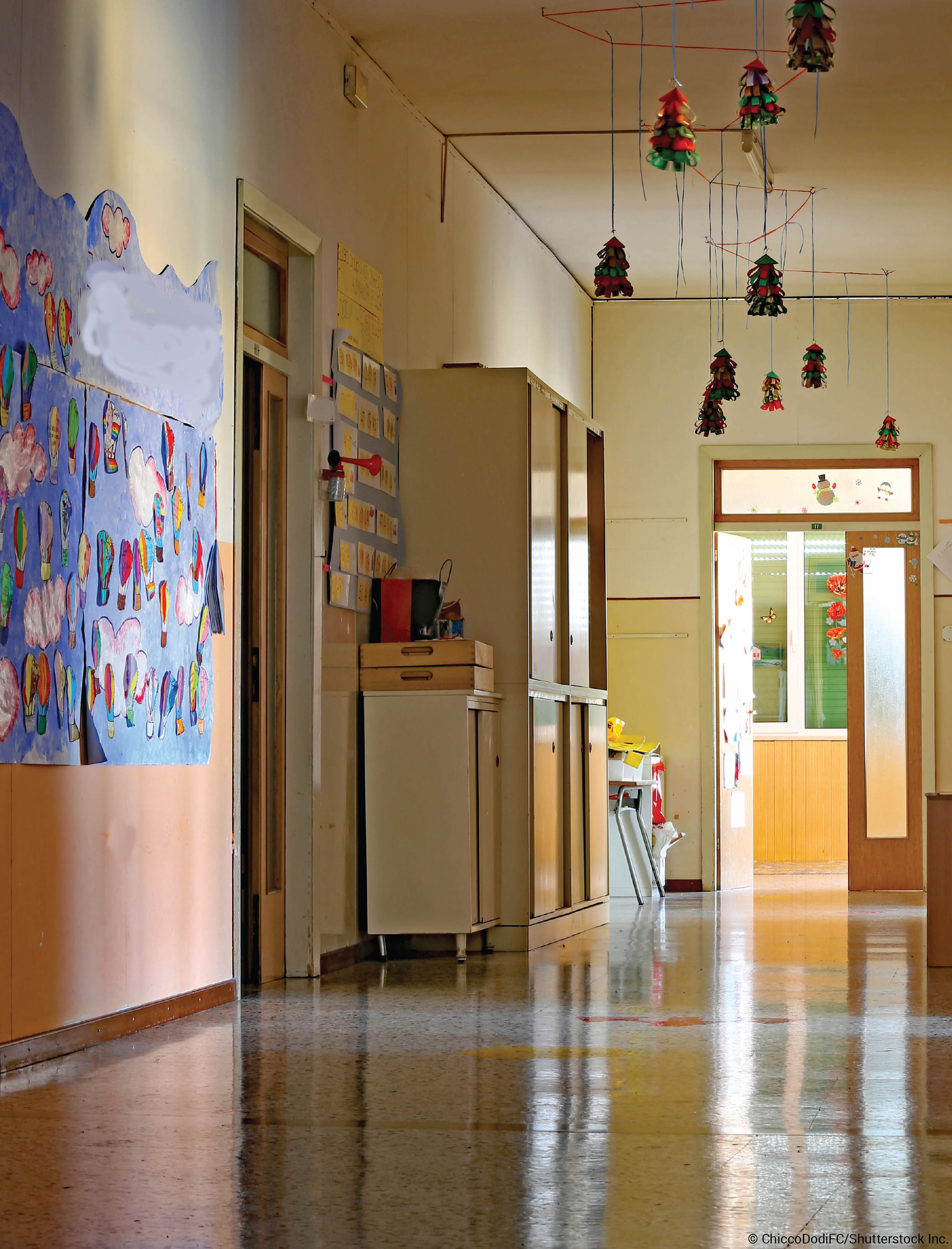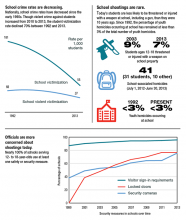High-profile school shootings, like the one at Marjory Stoneman Douglas High School in Parkland, Florida, have raised concerns that schools can be dangerous places for students. Yet the data suggest that school crime rates have dropped nationwide since the early 1990s and that the student victimization rate declined by 70% from 1992 to 2013 (see exhibit 1).[1]
To the general public, though, thoughts on school safety are often shaped by high-profile school shootings and other tragic incidents that dominate a news cycle. For educators, however, issues such as bullying, harassment, and school discipline policies are at the forefront of their thoughts and can affect school safety on a daily basis.
“It is very important that we continue working to understand and prevent mass shooter events,” said Phelan Wyrick, director of the Crime and Crime Prevention Research Division within NIJ’s Office of Research and Evaluation. “However, we cannot allow the saliency of mass shooter events to overshadow the importance of a wide range of more common safety issues that schools face.”
Shootings are just one of many traumatic events that children may face at school. They may also be threatened or injured by a weapon, be bullied, be physically assaulted, or be affected by natural disasters.
In support of stakeholder efforts to ensure that students are safe in school, NIJ has funded numerous initiatives over the years that evaluate school safety practices. These efforts range from how to prevent tragic incidents like school shootings to how to promote a positive school environment where day-to-day challenges, like bullying and harassment, can be reduced.
Historical School Safety Efforts
Although federal programs and policies related to school safety can be traced to the early 1970s, the United States did not begin collecting national data on school violence until 1989,[2] when the School Crime Supplement was added to the National Crime Victimization Survey. The School Crime Supplement was conducted for a second time in 1995 and then became a biannual survey starting in 1999.
A series of school shootings in the late 1990s, including the one that occurred at Columbine High School, led to new programs that examined the thinking, planning, and other pre-attack behaviors of school shooters. One such program was the Safe School Initiative led by the U.S. Department of Education and U.S. Secret Service.
As part of this initiative, NIJ supported a 2002 study that explored the behavior of student-attackers in an effort to identify information that could help communities prevent future attacks.[3] The study evaluated 37 incidents of targeted school violence in the United States between December 1974 and May 2000. It found that these 37 attacks were rarely sudden or impulsive. In 95% of the cases, the attacker had developed the idea to harm before the attack.
Perhaps most importantly, the study found that 93% of the evaluated attackers behaved in a way that caused others to be concerned or that indicated a need for help. In fact, in more than 75% of the cases examined, the attacker had told a friend, schoolmate, or sibling about the idea before taking action. But the person who was told about the attack rarely brought the information to an adult’s attention.
“That’s the critical element if we’re going to prevent, reduce, or head off these types of incidents from occurring,” Wyrick said. “We need to have mechanisms in place, school cultures amenable to folks reporting that information.”
The study also showed that there was no accurate profile of a school shooter. The shooters came from a variety of racial and ethnic backgrounds and ranged in age from 11 to 21 years old. Some came from intact families with ties to the community and others came from foster homes with histories of neglect. The academic performance of attackers ranged from excellent to failing.
Evaluating School Safety Technology
School security measures have increased since the Columbine shooting. Today, nearly 100% of schools serving 12- to 18-year-olds use at least one safety or security measure.[4] This includes locked doors, security cameras, hallway supervision, controlled building access, metal detectors, and locker checks. However, use of these measures varies by factors such as the school’s population and location.
NIJ has long supported studies on school safety technology, including one by Sandia National Laboratories. Released in 1999, The Appropriate and Effective Use of Security Technologies in U.S. Schools covered the effectiveness of a variety of school safety technologies. The report also provided basic guidelines for law enforcement agencies and school administrators as they decide which security technologies should be considered when developing safe school strategies. It helped schools and law enforcement partners analyze their vulnerability to violence, theft, and vandalism, and suggested possible technologies to address these problems effectively.
Overall, the report stated that security technologies are not the answer to all school security problems. No two schools will have identical and successful security programs, meaning that a security solution for one school cannot just be replicated at other schools with complete success. However, many pieces of technology can be excellent tools if applied appropriately.
More recently, NIJ has supported other school safety technology evaluations through the Comprehensive School Safety Initiative (CSSI). This initiative includes a report from the Library of Congress outlining federal school safety efforts between 1990 and 2016 and two complementary projects by the RAND Corporation and Johns Hopkins University, which assess current school technology and outline school needs.
These CSSI reviews of school safety technology shared a major conclusion: No one technology, school climate intervention, or other school safety strategy can guarantee school security or eliminate the underlying cause of school violence. An integrated approach that includes emergency response plans, drills, a positive school climate, and situational awareness is called for, and school security plans must be tailored to the needs of each individual school.
Comprehensive School Safety Initiative
Safety and security technology is just one tool in a comprehensive program that each school should develop to create a safe learning environment for students and staff. NIJ’s CSSI aims to make clear that there is no one solution to ensuring students are safe in school.
Developed following the tragedy at Sandy Hook Elementary School in 2012, CSSI is one of NIJ’s latest and largest investments in school safety research. Projects funded through CSSI examine different factors from the individual, school, community, and family levels that affect school safety.
A unique program of research for NIJ, CSSI provided funding for both implementation and evaluation as well as research projects that examine root causes. Under a directive from Congress, NIJ allocated approximately $75 million per year between fiscal years 2014 and 2017. Two-thirds of that funding went toward implementing school safety projects, and one-third went toward studying the impact of each program and the causes and consequences of school-related violence. Some CSSI projects have concluded and some are ongoing. They have covered or aim to address a wide range of school safety subjects, including school resource officer training, assessments of social media threats, bullying prevention, and positive behavioral interventions, among other topics.
This initiative will compile a large amount of information over a very short period of time, but the next few years will bring a wealth of knowledge on the effectiveness of school safety practices.
“We’re trying to move the field further and more quickly with so much information in such a short period of time,” said Mary Carlton, an NIJ social science analyst.
Through CSSI, NIJ has funded 96 studies with a focus on K-12 schools. These grant-funded projects are taking place in more than 30 states and more than 2,700 schools. The initial projects are still in the final stage, so it is too soon to assess the impact of the initiative. It may take six to seven years, if not longer, for the projects to reach their conclusions and for the results to be disseminated. Even after the last set of findings is published, taking that body of work and synthesizing it for the field may require another year or so of work, said Nadine Frederique, an NIJ senior social science analyst.
Moving Forward
School shootings are frightening and make headlines. However, today’s students are less likely to be threatened or injured with a weapon at school, including a gun, than they were 10 years ago.
But educators and public safety officials continue to grapple with the challenge of creating and maintaining a safe and healthy learning environment for students. Threats to schools and student safety continue from both inside and outside the school and from adults and other individuals, including students.
NIJ has sponsored numerous studies on the issues of school safety and school climate over the past 25 years and continues to support efforts to improve the safety of students in school. The outcomes of CSSI-funded research will provide valuable context for school officials in the coming years. The 96 projects funded through this effort examine a variety of school safety issues and offer an opportunity for educators, the community, and law enforcement to better understand the factors that most affect school safety.
About This Article
This article was published as part of NIJ Journal issue number 281, released June 2019




